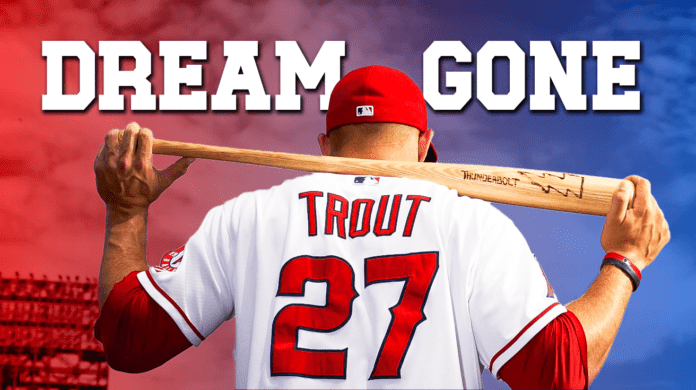
Mike Trout arrived in Major League Baseball as baseball’s chosen one, a prospect so hyped he needed his own zip code of expectations. His talent exploded onto the scene like fireworks on a clear summer night, a symphony of speed, power, and defensive wizardry that left scouts fumbling for new superlatives. But Trout’s story isn’t just about individual brilliance; it’s about the cruel mathematics of team sports where one plus twenty-four doesn’t always equal October glory.
While Trout compiled statistical monuments, his team constructed elaborate ways to miss the playoffs. His career evolved into baseball’s most magnificent soliloquy, a performance worthy of standing ovations delivered to increasingly empty theaters. Ranking his seasons reveals not just numbers but a Shakespearean baseball tragedy – individual heroism trapped in organizational mediocrity.
2011: The Overture
Nobody remembers the first pancake you make in the morning, and baseball historians might say the same about Trout’s initial big-league cameo. His MLB debut on July 8th arrived with trumpets, but his performance came with training wheels. After collecting his first hit on July 9th, reality introduced itself with a cold handshake, and by August 1st, he was headed back to the minors for more seasoning.
His 40-game trial projected to a 20-homer pace – not terrible, but not exactly what makes scouts’ clipboards flutter with excitement. At 19 turning 20, Trout’s raw talent needed only time and patience. This “worst season” served as the before picture in what would become baseball’s most dramatic transformation story.
2012: The Awakening
Baseball’s greatest rookie campaign since Fred Lynn wasn’t supposed to start in Triple-A. But that’s where Trout found himself after losing 12 pounds to a nasty flu and finding his outfield spot occupied. For one month, minor league pitchers faced a problem they couldn’t solve – Trout’s .403 batting average was less a statistic and more a distress signal from overwhelmed hurlers.
His April 28th call-up changed everything. Trout nearly pulled off the mythical .300/.400/.500 slash line while playing defense that made highlight reels apply for overtime. The MVP debate with Triple Crown winner Miguel Cabrera launched a thousand blog posts and previewed baseball’s coming civil war between traditional and advanced statistics. But 2012 announced Trout’s arrival as baseball’s new north star, the player against whom all others would be measured.
2013: The Confirmation
The hardest trick in sports isn’t reaching the summit – it’s building a summer home there. After his historic rookie explosion, Trout didn’t just avoid the sophomore slump; he kicked it down the stairs. His enhanced plate discipline raised his on-base percentage by 33 points, turning walks into an art form. Leading the AL in walks and OBP while appearing in 157 games, Trout answered the one-hit wonder question with emphatic force.
The Angels rewarded this consistency with a 6-year, $144 million extension – the baseball equivalent of putting a ring on it. Yet the MVP voters again sent Cabrera to the podium, reinforcing baseball’s complicated relationship with defining value. Still, Trout’s season confirmed 2012 wasn’t lightning in a bottle but rather the new weather forecast: expect Trout storms for the foreseeable future.
2014: The Coronation
After two years as baseball’s statistical emperor without crown, Trout finally claimed his MVP unanimously, despite showing the first hairline cracks in his game. High fastballs became his kryptonite, leading to strikeouts that piled up like parking tickets. His defensive metrics slipped from “Gold Glove” to merely “very good” – problems other players would solve by selling their souls.
The Angels won 98 games and Trout got his first playoff taste, but the Royals exposed his high-fastball weakness like they’d stolen his diary, overwhelming baseball’s best player both physically and mentally. For the first time, the superhero looked vulnerable, leaving fans to wonder: How does Superman respond when he discovers Kryptonite is real?
2015: The Adaptation
Great players master the game; legendary players rewrite their own code when the game masters them. After his high-fastball struggles, Trout didn’t sulk – he evolved. Strikeouts down, walks up, and power enhanced, Trout transformed his greatest weakness into a strength faster than you can say “adjustment.”
The newly implemented Statcast system captured Trout’s brilliance in high-definition data, tracking moonshots that probably needed FAA clearance. His second consecutive All-Star MVP solidified his status as baseball’s main attraction. Trout didn’t just close the hole in his swing; he renovated the entire house. This wasn’t just talent; this was talent plus determination plus baseball IQ forming a perfect storm of adaptation.
2016: The Balance
Baseball’s most perfect season doesn’t always win MVP, but 2016 saw the voters get it right. Trout showcased a balanced attack that would make a Swiss Army knife jealous – hitting for average (.315), power (29 HR), stealing bases (30), and playing improved defense. His 44% on-base percentage meant he was essentially living on first base, paying rent and receiving mail there.
Playing 159 games, Trout embodied durability in an era of load management and phantom IL stints. This season represented Trout at his most complete – the baseball equivalent of a perfect five-course meal. While the Angels continued their tradition of mediocrity, Trout’s brilliance couldn’t be ignored. His MVP award felt less like a victory and more like the correction of a clerical error from previous years.
2017: The What-If
Every sports fan knows the peculiar pain of the asterisk season – the “if only” campaign that haunts trophy cases. Through May 28th, Trout was manufacturing numbers that made statisticians check their calculators twice: on pace for 56 homers and 32 steals, with a wRC+ of 209 and OPS north of 1.200. These weren’t just MVP numbers; they were “rename the award after me” numbers.
Then baseball’s cruel randomness intervened. A wrist injury sidelined him for 39 games, robbing fans of what might have been the greatest individual season since Bonds made the record books tap out. Despite missing significant time, Trout still finished fourth in MVP voting – like showing up late to the exam and still scoring a B+. The season lives on in baseball’s parallel universe collection, a tantalizing glimpse of ceiling so high you’d need oxygen to reach it.
2018: The Peak
Baseball’s most overlooked masterpiece arrived in 2018, when Trout somehow found another gear on a machine already redlining. He posted career highs across categories that statheads worship: walks, on-base percentage, OPS, outs above average, and fielding run value. His 39 homers and 24 steals continued his membership in the power-speed club, while leading baseball in intentional walks – the ultimate sign of respect from terrified pitchers.
Despite missing three weeks with another wrist injury, his dominance remained statistical fact. Yet the MVP went to Mookie Betts, whose excellent season coincided with Boston’s championship run. The decision echoed baseball’s eternal question: Does “valuable” mean “best” or “best on a winning team”? Trout’s 2018 campaign now belongs in baseball’s museum of brilliant seasons that didn’t get the hardware they deserved.
2019: The Evolution
Athletes age like Benjamin Button in reverse – but the smart ones evolve before their bodies force the issue. In 2019, Trout embraced his final form: pure slugger. His pull rate, fly ball rate, and sweet spot percentage reached career peaks, resulting in 45 home runs that broke scoreboards and occasionally the laws of physics. The stolen base – once his secondary calling card – faded from his repertoire after August 31st.
His third MVP award (beating Alex Bregman) validated this new approach. While no longer the five-tool wunderkind of his early years, this version of Trout proved equally effective – just differently balanced. The baseball equivalent of a rock band swapping acoustic ballads for electric anthems, 2019 showed Trout could reinvent himself without sacrificing production.
2020-2023: The Mortality
Every superhero eventually meets their kryptonite, and for Trout, it arrived in the form of an injury cascade. Despite playing over 100 fewer games since 2020 than his elite peers, he still ranks 29th all-time in position player WAR – the statistical equivalent of winning a marathon while stopping for lunch. The pandemic-shortened 2020, a brilliant but brief 2021 until a calf strain intervened, position changes in 2022, and a broken hamate bone in 2023 – each chapter brought new challenges.
But writing Trout’s baseball obituary remains premature. Modern medicine and training techniques have extended prime years for athletes across sports. His combination of power, batting eye, and baseball instincts provides multiple paths forward. The greatest players reinvent themselves, and baseball’s most brilliant talent deserves the benefit of the doubt. Lightning can strike the same place twice, especially when that place is home plate and Mike Trout is in the batter’s box.


